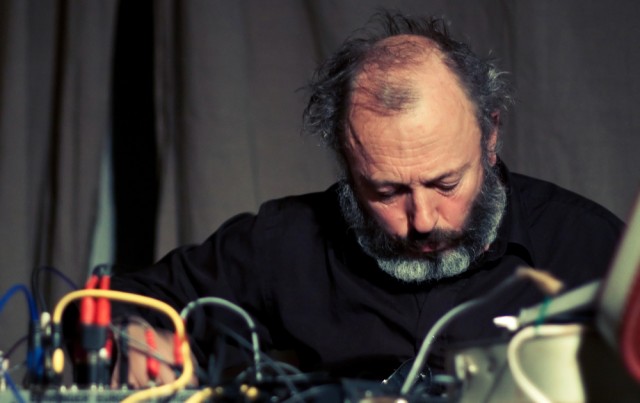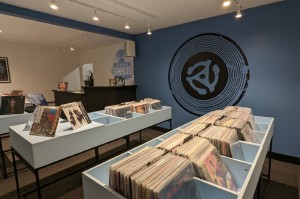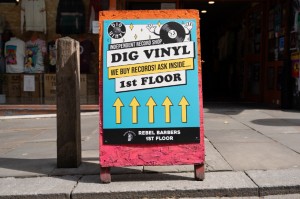Surreal And Optimistic: Philip Jeck’s Vinyl Requiem Replayed
What do 180 Dansette record players have to say about future forms of music and art? Alastair Dunn on a surreal composition that, 21 years on, still has something progressive to say about the spirit of creativity…
The move away from what may be considered the more ‘traditional’ modes of consumption and practice is one of the most discussed topics in the the digital age. Contrary to the love of digital formats, especially in music, there has been an astonishing resurgence in collecting vinyl, and increasing interest in analogue/lo-fi recording techniques; signalling, perhaps, an increased desire for the tangibility that these lost things provide.
With the proliferation of easy access, and the decrease in monetary returns, music has been the industry at the forefront of this transition in the popular imagination, and perhaps because of this, the break has been more visible and possibly more intrusive than in other industries.
In a world where recorded music and performances are often considered part of the public domain — and therefore free — how do performers and artists adapt and react? This is not a question concerned merely with the commercial aspects of the industry, but also one that questions how artists incorporate these ideas into their work.
In 1993, Liverpool-based musician/composer Philip Jeck and visual artist Lol Sargent began addressing some of these concerns when developing the ambitious and revelatory project Vinyl Requiem. The piece, a one-off performance, involved 180 Dansette record players, stacked and operated in tandem by three performers, whilst Jeck himself sat at the front amidst a circle of several more record players orchestrating proceedings.
Sargent’s contribution was to provide layered projections, which were then beamed onto this uncanny construction as the music unfolded. Intended originally as a send-off for the vinyl medium as a mainstream format at the dawn of the burgeoning CD-Rom revolution, the piece has been revived 21 years later for a series of outings. Though Jeck has insisted in interviews that the timing of this revival is coincidental, it seems remarkable considering the history of recorded music for these commentaries to be unfurled and revisited now.
Situated as a cultural centre in the city of Liverpool, the Bluecoat is a perfect a venue in which to witness Vinyl Requiem Replayed. Considering the scale of the original performance, the two artists have opted not to recreate it but to present a scaled-down version that can be viewed on a large screen in small settings.

As late-comers take their seats, all of which are gratifyingly full, the lights dim and Jeck and Sargent enter silently to take their places at the back and front of the room, respectively. The projector behind the audience clicks and we are met with footage of the original performance. Shot in Betamax, time has rendered an eerie haze upon the footage.
Images of the scaffolding, assembled to make up three levels on which the Dansettes are stacked, resemble the shelves of some strange library for the technologically deceased. Three operators, clad in white jumpsuits, move along the shelves, their robotic movements and attire lending the scenario a sense of Orwellian dystopia.
Alongside the pre-recorded audio recordings of this performance, Jeck provides a live musical accompaniment. For this he uses two record players, two mini-disc players, several effects pedals and a MIDI keyboard. Through continuous loops, he creates an unsettling and hypnotic sonic experience that speaks to the piece as a whole, whilst remaining engrossing in isolation.
The idea of Jeck accompanying, essentially, a past version of himself seems to encapsulate the conceptual nature of what we are witnessing. The notion that the requiem is ‘replayed’, rather than ‘re-made’, evokes the transitory nature of musical formats whilst also confirming for them a fixed moment in time. Regeneration, this suggests, is an inherent process in the creation of art and something to be embraced.
Using singular musical artefacts, such as vinyl, to build something larger and ultimately far removed from the original, appears as a statement about the way in which culture is produced through recycling and re-appropriation. Post-modernist works across mediums, such as William S. Burroughs’ Naked Lunch, spring to mind. This sense of re-invention through both self and cultural reference lingers throughout the film’s hour-long duration.
Though the audio — and surreal slides provided by Sargent — are disquieting, it becomes apparent that this point of regeneration can only be a positive one. When it is was first played over two decades ago it was, seemingly, a melancholic sigh. While this sigh still resonates, the surreal and often unintelligible aspects of this performance avoid entirely masking what appears to be a sense of optimism about the future forms of music and art. It bemoans the death of an industry rather than any creative stifling these periods of transition may cause.
This sense of optimism is worth holding onto. In a climate of illegal downloading that borders on the nihilistic, it is refreshing to witness an exhibition that espouses the virtues of past and passing modes of operation that is not overly nostalgic but progressive. The piece gains additional significance when considering that even some 21 years after the vinyl death knell was rung, more and more artists are opting to release new music on vinyl.
Vinyl Requiem Replayed offers no solutions to the litany of problems in the recording industry, but that is not to suggest this is a bad thing. In fact, that the performance raises more questions than it answers is testament not only to its strength as an artwork, but also to the profundity of thought of its creators.
Alastair Dunn
Philip Jeck studied visual art at Dartington College of Arts. He started working with record players and electronics in the early ’80s and has made soundtracks and toured with many dance and theatre companies as we as well as his solo concert work. More on Jeck’s website: philipjeck.com
Image courtesy Dave Knapik





